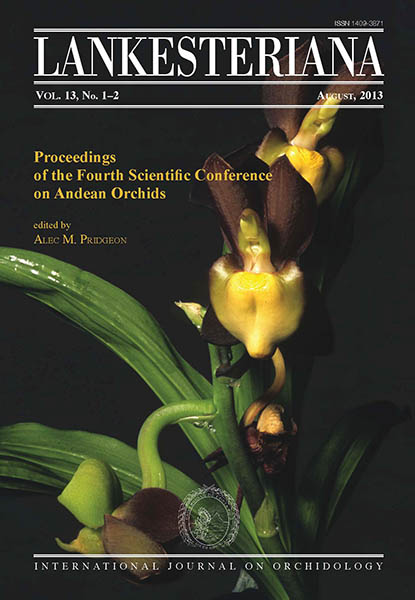Diversidad de orquídeas de las diferentes formaciones vegetales de los Andes peruanos
DOI:
https://doi.org/10.15517/lank.v0i0.11546Keywords:
orchidaceae, perú, desierto costero, zonas altoandinas, valles interandinosAbstract
Due to the presence of the Andes Cordillera and the Humboldt Current, Peru has a great diversity of plant communities. For example, while the lowlands to the west of the Peruvian Andes are characterized mainly by being a semi-desert belt with dry forest, shrublands, and mostly seasonal vegetation formations, the eastern side of the Andes is covered by a vast wet forest of high biodiversity. In contrast to the lowlands on either side of the Andes, the Andean highlands throughout Peru are not as contrasting, although there are floristic differences because of diminishing humidity toward the south. Epiphytic orchids, which are distributed mainly in the montane forests of the eastern slopes of the Peruvian Andes, have been the goal of numerous botanical expeditions in order to document their diversity. By contrast, Peruvian terrestrial orchids have not received the same attention, although they are found throughout the country, from the deserts, xerophytic shrublands, wetlands at high elevations, even in areas where exotic species such as Eucalyptus globulus forest have been introduced. The present contribution describes the vegetation of the desert coast, inter-Andean valleys and highlands of Peru, as well as orchids that have been recorded in each vegetation type.Downloads
Download data is not yet available.
Downloads
How to Cite
Trujillo, D. (2013). Diversidad de orquídeas de las diferentes formaciones vegetales de los Andes peruanos. Lankesteriana: International Journal on Orchidology, 13(1-2). https://doi.org/10.15517/lank.v0i0.11546
Issue
Section
Articles
License
According to the Open Access policy promoted by the University of Costa Rica, all the papers published by Lankesteriana are licensed under the Creative Commons copyright and can be downloaded free of charge. The journal holds copyright and publishing rights under the CC BY-NC-ND 3.0 CR license.
Before the publication of the materials submitted by the author(s) in LANKESTERIANA, the author(s) hereby assign all rights in the article to the Lankester Botanical Garden.





